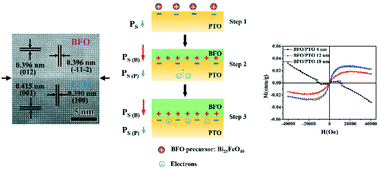当前位置:
X-MOL 学术
›
CrystEngComm
›
论文详情
Our official English website, www.x-mol.net, welcomes your feedback! (Note: you will need to create a separate account there.)
Polarization screening-induced epitaxial growth and interfacial magnetism of BiFeO3/PbTiO3 nanoplates
CrystEngComm ( IF 3.1 ) Pub Date : 2020/01/09 , DOI: 10.1039/c9ce01862j Gangjie Fu 1, 2, 3, 4, 5 , Wei Li 1, 2, 3, 4, 5 , Haiwen Cao 1, 2, 3, 4, 5 , Xing Chen 1, 2, 3, 4, 5 , Shanpeng Wang 5, 6, 7, 8 , Liang Luo 9, 10, 11, 12 , Mengjiao Wu 1, 2, 3, 4, 5 , He Tian 1, 2, 3, 4, 5 , Zhaohui Ren 1, 2, 3, 4, 5 , Gaorong Han 1, 2, 3, 4, 5
CrystEngComm ( IF 3.1 ) Pub Date : 2020/01/09 , DOI: 10.1039/c9ce01862j Gangjie Fu 1, 2, 3, 4, 5 , Wei Li 1, 2, 3, 4, 5 , Haiwen Cao 1, 2, 3, 4, 5 , Xing Chen 1, 2, 3, 4, 5 , Shanpeng Wang 5, 6, 7, 8 , Liang Luo 9, 10, 11, 12 , Mengjiao Wu 1, 2, 3, 4, 5 , He Tian 1, 2, 3, 4, 5 , Zhaohui Ren 1, 2, 3, 4, 5 , Gaorong Han 1, 2, 3, 4, 5
Affiliation

|
In this work, single-crystal BiFeO3/PbTiO3 (BFO/PTO) nanoplates have been successfully synthesized via a hydrothermal method. It is interesting to find that BFO films selectively grew on the negative polar surface of PTO nanoplates with a saturation thickness of about 18–20 nm. Below such saturation size, the thickness of BFO films can be controlled in the range of 4–18 nm. An atomically sharp interface was identified to be formed between BFO and PTO with an epitaxial relationship of {012}BFO//{001}PTO. In particular, a room-temperature ferromagnetism in the nanoplates has been observed, where the saturation magnetization significantly decreased from to 0.029 to 0.003 emu g−1 upon the film thickness decreasing to 4 nm. Electron energy-loss spectroscopy (EELS) analysis on the interface suggests that the positive polar surface of BFO could be screened by both of the negative polarization and addition electrons in PTO. A mechanism of “screening balance broken and rebuilt” on the negative interface was proposed to explain the existence of selective growth, the saturation thickness and magnetism of the nanoplates. The findings suggest that a polar surface could be a powerful platform to realize the controllable epitaxial growth of perovskite oxide heterostructures with the intriguing interface functionality.
中文翻译:

极化屏蔽诱导BiFeO3 / PbTiO3纳米板的外延生长和界面磁性
在这项工作中,通过水热法成功地合成了单晶BiFeO 3 / PbTiO 3(BFO / PTO)纳米板。有趣的是,发现BFO膜在PTO纳米板的负极表面选择性生长,其饱和厚度约为18–20 nm。低于此饱和尺寸,可以将BFO膜的厚度控制在4-18 nm。确认在BFO和PTO之间形成了原子上尖锐的界面,其外延关系为{012} BFO // {001} PTO。特别地,已经观察到纳米板中的室温铁磁性,其中饱和磁化强度从降低到0.029 e0.00 g emu g -1到0.003 emu g -1在膜厚度减小到4nm时。界面上的电子能量损失谱(EELS)分析表明,BTO的正极性表面可以通过PTO中的负极性和附加电子进行筛选。为了解释纳米板选择性生长,饱和厚度和磁性的存在,提出了一种在负界面上“屏蔽平衡破碎并重建”的机制。研究结果表明,极性表面可能是实现具有有趣界面功能的钙钛矿氧化物异质结构可控外延生长的强大平台。
更新日期:2020-02-10
中文翻译:

极化屏蔽诱导BiFeO3 / PbTiO3纳米板的外延生长和界面磁性
在这项工作中,通过水热法成功地合成了单晶BiFeO 3 / PbTiO 3(BFO / PTO)纳米板。有趣的是,发现BFO膜在PTO纳米板的负极表面选择性生长,其饱和厚度约为18–20 nm。低于此饱和尺寸,可以将BFO膜的厚度控制在4-18 nm。确认在BFO和PTO之间形成了原子上尖锐的界面,其外延关系为{012} BFO // {001} PTO。特别地,已经观察到纳米板中的室温铁磁性,其中饱和磁化强度从降低到0.029 e0.00 g emu g -1到0.003 emu g -1在膜厚度减小到4nm时。界面上的电子能量损失谱(EELS)分析表明,BTO的正极性表面可以通过PTO中的负极性和附加电子进行筛选。为了解释纳米板选择性生长,饱和厚度和磁性的存在,提出了一种在负界面上“屏蔽平衡破碎并重建”的机制。研究结果表明,极性表面可能是实现具有有趣界面功能的钙钛矿氧化物异质结构可控外延生长的强大平台。



























 京公网安备 11010802027423号
京公网安备 11010802027423号